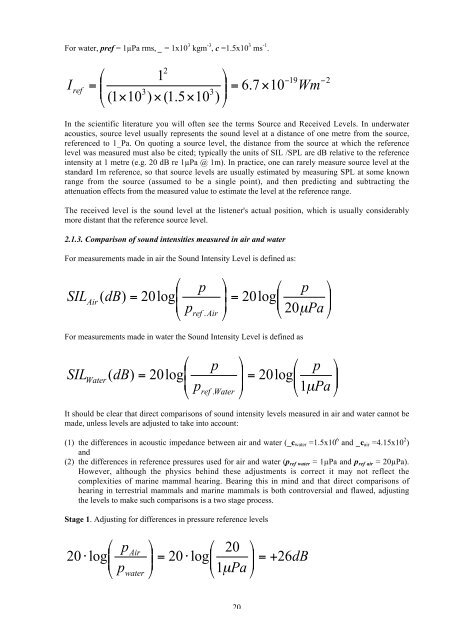Oceans of noise - Whale and Dolphin Conservation Society
Oceans of noise - Whale and Dolphin Conservation Society
Oceans of noise - Whale and Dolphin Conservation Society
You also want an ePaper? Increase the reach of your titles
YUMPU automatically turns print PDFs into web optimized ePapers that Google loves.
For water, pref = 1µPa rms, _ = 1x10 3 kgm -3 , c =1.5x10 3 ms -1 .<br />
I ref<br />
⎛<br />
⎞<br />
= ⎜ 3<br />
( 1 10 ) ( 1.<br />
5 10 ) ⎟ Wm<br />
⎝ × × × ⎠<br />
2<br />
1 −19<br />
−2<br />
⎟ = 6.<br />
7 × 10<br />
3<br />
In the scientific literature you will <strong>of</strong>ten see the terms Source <strong>and</strong> Received Levels. In underwater<br />
acoustics, source level usually represents the sound level at a distance <strong>of</strong> one metre from the source,<br />
referenced to 1_Pa. On quoting a source level, the distance from the source at which the reference<br />
level was measured must also be cited; typically the units <strong>of</strong> SIL /SPL are dB relative to the reference<br />
intensity at 1 metre (e.g. 20 dB re 1µPa @ 1m). In practice, one can rarely measure source level at the<br />
st<strong>and</strong>ard 1m reference, so that source levels are usually estimated by measuring SPL at some known<br />
range from the source (assumed to be a single point), <strong>and</strong> then predicting <strong>and</strong> subtracting the<br />
attenuation effects from the measured value to estimate the level at the reference range.<br />
The received level is the sound level at the listener's actual position, which is usually considerably<br />
more distant that the reference source level.<br />
2.1.3. Comparison <strong>of</strong> sound intensities measured in air <strong>and</strong> water<br />
For measurements made in air the Sound Intensity Level is defined as:<br />
SIL<br />
Air<br />
⎛<br />
( dB)<br />
= 20log⎜<br />
⎜<br />
⎝ p<br />
p<br />
ref . Air<br />
⎞<br />
⎟<br />
⎛ p ⎞<br />
= 20log⎜<br />
⎟<br />
⎟<br />
⎠ ⎝ 20µ<br />
Pa ⎠<br />
For measurements made in water the Sound Intensity Level is defined as<br />
SIL<br />
Water<br />
⎛<br />
( dB)<br />
= 20log⎜<br />
⎜<br />
⎝ p<br />
p<br />
ref . Water<br />
20<br />
⎞<br />
⎟<br />
⎛ p ⎞<br />
= 20log⎜<br />
⎟<br />
⎟<br />
⎠ ⎝1µ<br />
Pa ⎠<br />
It should be clear that direct comparisons <strong>of</strong> sound intensity levels measured in air <strong>and</strong> water cannot be<br />
made, unless levels are adjusted to take into account:<br />
(1) the differences in acoustic impedance between air <strong>and</strong> water (_cwater =1.5x10 6 <strong>and</strong> _cair =4.15x10 2 )<br />
<strong>and</strong><br />
(2) the differences in reference pressures used for air <strong>and</strong> water (pref water = 1µPa <strong>and</strong> pref air = 20µPa).<br />
However, although the physics behind these adjustments is correct it may not reflect the<br />
complexities <strong>of</strong> marine mammal hearing. Bearing this in mind <strong>and</strong> that direct comparisons <strong>of</strong><br />
hearing in terrestrial mammals <strong>and</strong> marine mammals is both controversial <strong>and</strong> flawed, adjusting<br />
the levels to make such comparisons is a two stage process.<br />
Stage 1. Adjusting for differences in pressure reference levels<br />
⎛ p ⎞ ⎛ 20 ⎞<br />
20 ⋅ log ⎜ = 20 ⋅ log⎜<br />
⎟ = +<br />
p ⎟<br />
⎝ water ⎠ ⎝1µ<br />
Pa ⎠<br />
Air 26<br />
dB

















